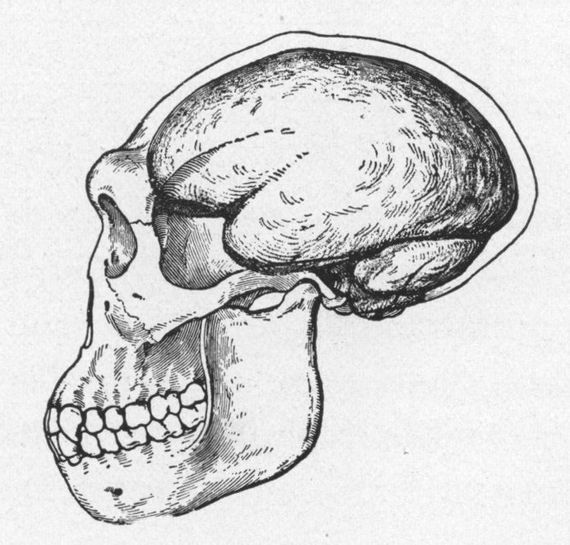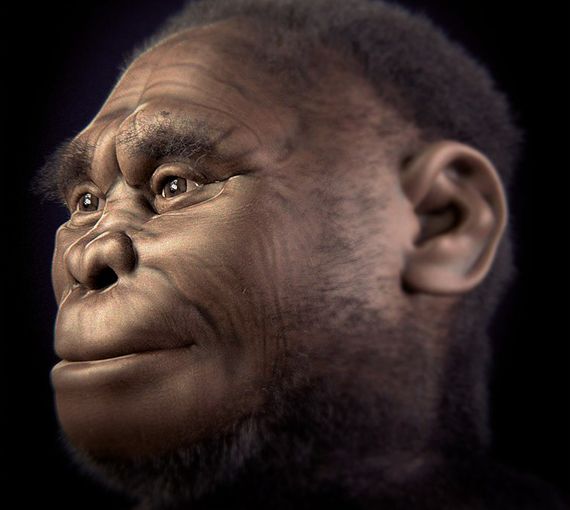The Human Lineage Grows and Gets Complicated: From “Missing Link” to Tree to Network
In the 19th century, when it began to be understood that the
human being was a species that emerged, like all the others, through a
process of biological evolution, an expression arose: the “missing
link,” the ape-man who was supposed to connect Homo sapiens
with the apes, like a snapshot to be glued into an empty spot in the
family album. When Eugène Dubois discovered the remains of Java Man, an
extinct species he named Anthropopithecus erectus (later Pithecanthropus erectus, today Homo erectus), the Dutch paleoanthropologist soon announced to the world that he had finally discovered the missing link.

Dubois’s proclamation was debated at the time, but one image has
survived to this day: an orderly single file showing an evolution from
monkeys to Homo sapiens, as if the former were half-made beings. Last December, when the magazine PaleoAnthropology published a whole series of studies on Australopithecus sediba, an African hominin described in 2010, various media headlines announced that the “missing link” had been found.
The main author of the find, Lee Berger, at the University of
Witwatersrand (South Africa), had to issue a press release clarifying
that neither is the sediba the missing link, nor does such a link exist.
Scott Williams, from New York University, one of the sediba
researchers and co-editor of the issue dedicated to this species, tells OpenMind: “I think missing link should be avoided.” According to Williams, the scientists themselves had a hard time getting away from the scala naturae or the Great Chain of Being, the Greco-medieval idea that nature is organized in a linear hierarchy, from minerals to humans.
The human lineage, a bushy tree
It was in the 20th century that the concept began to be abandoned,
but not without first claiming the title of the famous link for other
species such as Homo habilis or Australopithecus afarensis (the famous Lucy), and even for some well-orchestrated frauds like the Piltdown Man.
But then it began to be revealed that the human lineage was not a
single file, but “a bushy tree, and getting bushier,” in the words of
Brian Villmoare, at the University of Nevada in Las Vegas. Recent
findings have increased the human family to some 25 species that lived
in the last six or seven million years. So complex has the picture
become that evolutionary geneticist Mark Thomas has compared it to the world that JRR Tolkien envisioned in The Lord of the Rings.
To this complexity is added the wrinkle that, according to Williams,
“although it is theoretically possible to discover direct ancestors of
living species, it is extremely improbable.” Therefore, nowadays
researchers tend to define species as “sister taxa,” lineages that share
a common ancestor, such as modern humans and Neanderthals. “Our efforts
should be spent testing hypotheses of sister relationships rather than
ancestral-descendant relationships,” adds Williams. “In our introduction
to the special issue, we are very careful in talking about A. sediba as the potential sister taxon to the genus Homo, not its ancestor.”

This approach is especially timely when new findings are breaking the
classic patterns about how and where the extinct species of the human
family were related. Traditionally, the most primitive members, such as
the australopithecines, dated between three and four million years ago,
were located in East Africa. Others with more modern features, such as H. erectus, would have migrated later from Africa to Eurasia, to be later replaced by African H. sapiens.
But the sediba is one of the species that has shaken up this lineage,
rejuvenating the survival of its genus by up to two million years. On
the other hand, H. naledi, an archaic human, extended our genus Homo to southern Africa, but at the same time a finding co-discovered by Villmoare pushed back the origin of Homo to 2.8 million years ago. Even more unexpectedly, in 2017 a study described the oldest remains of H. sapiens, dated at 300,000 years old, but not in eastern or southern Africa, but in Morocco.
The mystery of the Denisovans
Outside of Africa, the picture is not clear either. There is still
the mystery of the Denisovans, a population whose first remains were
found in a cave in Siberia in 2008 and which had the novelty of being
described by their DNA sequence. The Denisovans have been described as
the Asian Neanderthals, since they were also contemporaries of H. sapiens.
However, they have not yet received formal status as a species.
According to Bence Viola, from the University of Toronto (Canada) and
co-author of the recent discovery of a Denisovan skull fragment,
“the bigger problem is the whole issue of what a species is.” “But of
course the new fossils are very informative, and in my opinion they
reinforce the argument that they were a separate population and probably
very widespread in Asia.”

Also in Asia, H. floresiensis —known as the hobbit—
was a tiny human with primitive features who lived on the island of
Flores (Indonesia) until less than 100,000 years ago. Another species, H. luzonensis,
which inhabited the Philippines only 67,000 years ago, has recently
been described. “We continue to realize that a few thousand years back
in time, H. sapiens was definitely not alone on Earth,” Florent
Détroit, the study’s co-author of the National Museum of Natural
History in Paris, tells OpenMind. “The scenario was clearly much more complex than just H. sapiens replacing H. erectus.”
New datings
And it could be even more so. Darren Curnoe, from the University of
New South Wales (Australia), discovered in China the skeletal remains of
archaic humans he calls the red deer cave people, more similar to H. erectus than to H. sapiens. Initially Curnoe and his collaborators dated these remains at only 14,000 years old, but their most recent studies indicate that they are probably much older, “perhaps in the range of 177,000 to 112,000 years,” he tells OpenMind.

In fact, Curnoe fears that some of the mysteries arising today are
due to faulty dating: “I think that many palaeoanthropologists are
not paying anywhere near enough careful attention to dating the sites
and the human remains they find,” he says. Curnoe is especially critical
of the datings of H. naledi or H. luzonensis, and has even questioned the status of the latter as a species.
But if new datings can clarify the human family album, other findings
are instead contributing to muddying the waters even more. In recent
years it has been discovered that H. sapiens, Denisovans and
Neanderthals produced common offspring among them. From the idea of the
missing link we moved on to the evolutionary tree, but today even this
description no longer seems valid; rather we are facing a network with
multiple connections that intersect, like a prehistoric internet of
human evolution.
Nenhum comentário:
Postar um comentário
Observação: somente um membro deste blog pode postar um comentário.